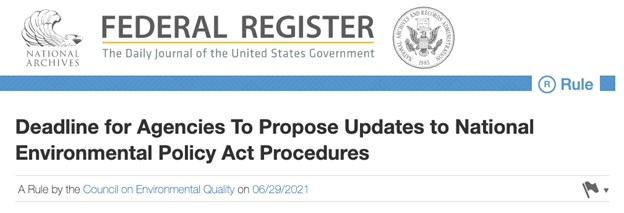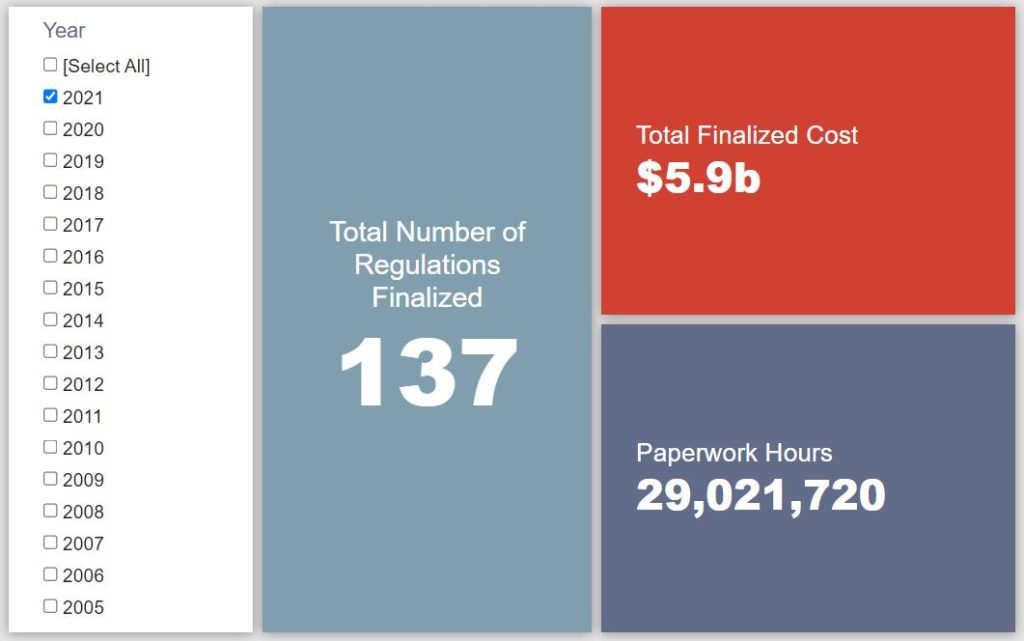Week in Regulation
July 6, 2021
Another Trump-Era Reversal Leaves Its Mark
The shift from June to July had a largely unremarkable regulatory haul except for one Department of Health and Human Services (HHS) proposal seeking to pull back a Trump Administration rulemaking. Since that Trump-era rule was net-regulatory due to its administrative requirements, however, this proposed reversal accounts for a cost-cutting measure – in a significant way. Across all rulemakings, agencies published roughly $1.3 billion in total net cost savings and cut 2.8 million annual paperwork burden hours.
REGULATORY TOPLINES
- Proposed Rules: 55
- Final Rules: 73
- 2021 Total Pages: 35,322
- 2021 Final Rule Costs: $5.9 billion
- 2021 Proposed Rule Costs: -$13.4 billion
NOTABLE REGULATORY ACTIONS
The most notable rulemaking of the week was the HHS proposed rule regarding “Patient Protection and Affordable Care Act; Updating Payment Parameters, Section 1332 Waiver Implementing Regulations, and Improving Health Insurance Markets for 2022 and Beyond Proposed Rule.” The rulemaking seeks to make a series of changes to various aspects of regulatory programs under the Affordable Care Act, largely focusing on shifts in transfer payments. The main regulatory shift, however, would be to revert a Trump-era provision, that required covered insurance providers “that offer coverage of abortion services for which federal funds are prohibited to separately bill for this portion of the policy holder’s premium and to instruct the policy holder to pay for the separate bill in a separate transaction,” back to the Obama-era policy on the matter. HHS estimated that this reversal would provide estimated savings of roughly $270 million annually, due in large part to eliminating the nearly 3 million annual hours of paperwork imposed by the Trump-era rule.
CONGRESSIONAL REVIEW ACT UPDATE
On March 23, the first joint resolution of disapproval under the Congressional Review Act (CRA) of this term was introduced. CRA resolutions essentially seek to wholly rescind specific final rules within a set timeframe. The significance of these resolutions is discussed further here. In the interest of providing a public accounting of the potential economic impact of these actions should they pass, the American Action Forum (AAF) has provided a regular update of the rules being targeted and a concise summary of each rule’s purpose, economic impact, and why opponents may be targeting it.
Last Wednesday, President Biden signed into law the three CRA resolutions that recently passed through Congress. Since the timeframe for filibuster-proof consideration of CRA resolutions in the Senate has long since passed, these three resolutions will (barring some extraordinary development) effectively be the last significant CRA actions during this Congress. As such, AAF will retire this Week in Regulation section until there is such a time that developments require its inclusion again.
TRACKING THE ADMINISTRATIONS
As we have already seen from executive orders and memos, the Biden Administration will surely provide plenty of contrasts with the Trump Administration on the regulatory front. And while there is a general expectation that the new administration will seek to broadly restore Obama-esque regulatory actions, there will also be areas where it charts its own course. Since the AAF RegRodeo data extend back to 2005, it is possible to provide weekly updates on how the top-level trends of President Biden’s regulatory record track with those of his two most recent predecessors. The following table provides the cumulative totals of final rules containing some quantified economic impact from each administration through this point in their respective terms.
![]()
Since last week’s most significant action happened on the proposed rule side, there was minimal change to the Biden Administration’s final rule tally. Similarly, the Trump Administration agencies largely stood pat at this time. The main mover in this regard was the Obama Administration. Those shifts largely came from a Department of Agriculture rule with nearly $200 million in costs and a Department of Treasury rule that increased the paperwork total by more than two million hours.
THIS WEEK’S REGULATORY PICTURE
By Rose Laoutaris, Regulatory Policy Intern
This week the Council on Environmental Quality (CEQ) extended the deadline for agencies to comply with its 2020 National Environmental Policy Act (NEPA) rule by two years.

On June 29, the CEQ published an interim final rule in the Federal Register extending the compliance deadline for its 2020 final NEPA rule. This extension comes after President Biden signed two executive orders (EOs) in the early days of his presidency: EO 13,990, Protecting Public Health and the Environment and Restoring Science to Tackle the Climate Crisis, and EO 14,008, Tackling the Climate Crisis at Home and Abroad.
EO 13,990 ordered federal agencies to review agency actions from the Trump Administration to ensure they were based on science. The EO specifically mentioned the “2020 rule,” which limited the scope of NEPA review in order to speed up environmental reviews and reduce delays. The EO also required federal agencies to set their own rules on how they will comply with the CEQ rule by September of this year.
EO 14,008 requires the chair of the CEQ and the director of the Office of Management and Budget to ensure that federal infrastructure investments are lowering climate pollution and consider greenhouse gas emissions.
The Biden Administration found that the 2020 rule did not allow the CEQ to adequately meet the goals of EO 13,990 and EO 14,008, so it reversed the rule. Federal agencies must continue to follow the original rule until the administration can finalize its reversal. As a result, agencies still must issue rules on how they will follow the CEQ 2020 rule, so in order to avoid violating this rule, the Biden Administration is extending the deadline.
CEQ did this extension through an interim final rule, which means they were able to bypass public comment. This rulemaking avenue is only allowed in certain circumstances permitted under the Administrative Procedure Act. The Biden Administration justified the use of this avenue in this case because the extension is a rule “of agency organization, procedure, or practice” and does not “encode a substantive value judgement.” It also stated that it was for “good cause” because the September deadline was approaching soon, so it had to implement the rule quickly.
TOTAL BURDENS
Since January 1, the federal government has published $7.5 billion in total net cost savings (with $5.9 billion in new costs from finalized rules) and 17.4 million hours of net annual paperwork burden increases (with 29 million hours in increases from final rules).












